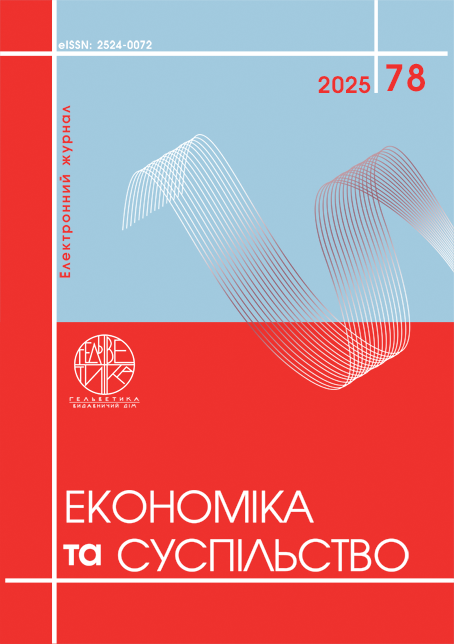PROBLEMATIC ASPECTS ON THE FORMATION OF HUMAN RESOURCES POTENTIAL OF AGRICULTURAL ENTERPRISES IN THE PERIOD OF POSTWAR RECONSTRUCTION
Abstract
The study examines the formation and optimization of human resource potential in agricultural enterprises during the post-war recovery period. The relevance of this topic is determined by the urgent need to restore the agricultural sector, which plays a crucial role in ensuring food security and economic stability. The primary objective is to identify effective strategies for overcoming workforce shortages, adapting personnel management to new economic conditions, and enhancing labor productivity through innovative approaches. Given the significant demographic shifts, migration trends, and transformation of labor market demands, the development of a sustainable human resource management system is essential for stabilizing agricultural production and fostering long-term sectoral growth. To achieve this goal, a combination of systematic, comparative, and statistical analysis methods was employed. The research is based on an assessment of labor resource dynamics, structural transformations in employment, and the effectiveness of various personnel management strategies. The methodological approach ensures a comprehensive evaluation of the factors influencing workforce development and allows for the formulation of evidence-based recommendations. The findings reveal that the introduction of digital technologies, expansion of educational initiatives, and the implementation of adaptive HR policies significantly contribute to strengthening the agricultural workforce. The study demonstrates that attracting young professionals through financial and professional incentives, improving working conditions, and enhancing access to training programs are key drivers of labor market stabilization. Moreover, the role of government support and private sector participation in fostering human capital development is emphasized, highlighting the necessity of coordinated efforts to ensure workforce sustainability. The practical significance of the research lies in its strategic recommendations for optimizing personnel management, increasing labor retention, and enhancing workforce resilience in rural areas. The proposed measures contribute to the efficient utilization of human resources, support economic recovery, and create favorable conditions for long-term development in the agricultural sector. The study underscores the importance of a holistic and adaptive approach to human resource management, integrating digital transformation, continuous learning strategies, and innovative employment policies to build a competitive and sustainable agricultural labor market.
References
Вартанова О.В., Клецова К.В., Кузьменко О.М. та ін. Конкурентоспроможність персоналу підприємства. Луганськ : Вид-во "Ноулідж", 2011. 176 с.
Вініченко І. І., Дідур К. М., Ткач А. О. Роль трудового потенціалу в досягненні економічної безпеки аграрних підприємств. Агросвіт. 2024. № 1. С. 22-31. DOI: https://doi.org/10.32702/2306-6792.2024.1.22
Гринкевич С. С. Методичний інструментарій дослідження трудового потенціалу в розрізі його компонентної структури. Соціальна економіка і політика. Економічний часопис-ХХІ. 2011. № 7–8. 5457 c.
Грішнова О. А. Економіка праці та соціально-трудові відносини. К.: Знання. 2006. 559 с.
Кооперація та ESOP в Україні – на шляху до інклюзивної економіки. Матеріали круглого столу в Верховній Раді України. 2016. URL: https://www.rada.gov.ua/print/138441.html (дата звернення: 17.03.2025).
МОМ. Агентство ООН з питань міграції. Міграція в Україні. Цифри і факти. Випуск № 5. 2021. URL: https://ukraine.iom.int/uk/resources/mihratsiya-v-ukrayini-tsyfry-i-fakty-2021(дата звернення: 17.03.2025).
Середня місячна заробітна плата за галузями. Дані Міністерства фінансів України за 2024 рік. URL: https://index.minfin.com.ua/ua/labour/salary/average/branch/2024/ (дата звернення: 17.03.2025).
Судаков М., Лісогор Л. Ринок праці України: 2022–2023: стан, тенденції та перспективи. 2023. URL: https://solidarityfund.org.ua/wp-content/uploads/2023/04/ebrd_ukraine-lm-1.pdf (дата звернення: 17.03.2025).
Суліма Н., Гуцул Т., Боровик Н. Формування ресурсного потенціалу аграрних підприємств в умовах інноваційного розвитку. Економіка та суспільство. 2024. Вип. № 63. DOI: https://doi.org/10.32782/2524-0072/2024-63-47
Чайковський Ю. В. Вплив сучасних конфліктів на зміну міграційної політики сусідніх держав: міжнародно-правові аспекти. Актуальні проблеми політики.2018. Вип. № 62. С. 81-94.
Шура Н. О. Підвищення кадрового потенціалу підприємств у сучасних умовах господарювання. Ефективна економіка. 2020. № 6. DOI: https://doi.org/10.32702/2307-2105-2020.6.75
Vartanova, O. V., Kletsova, K. V. Kuzmenko, O. M. (2011). Konkurentospromozhnist personalu pidpryiemstva [The competitiveness of company staff]. Luhansk : Vyd-vo Noulidzh. 176 р. [in Ukrainian]
Vinichenko I. I., Didur K. M., Tkach A. O. (2024). Rol trudovoho potentsialu v dosiahnenni ekonomichnoi bezpeky ahrarnykh pidpryiemstv [The role of labor potential in achieving the economic security of agricultural enterprises]. Ahrosvit. No. 1, pp. 22-31. DOI: https://doi.org/10.32702/2306-6792.2024.1.22 [in Ukrainian].
Hrynkevych S. (2011) Metodychnyy instrumentariy doslidzhennya trudovoho potentsialu v rozrizi yoho komponentnoyi struktury [Methodological toolkit for the study of labor potential in terms of its component structure]. Sotsialʹna ekonomika i polityka. Ekonomichnyy chasopys-ХХІ. No. 7-8, рр. 54-57 [in Ukrainian].
Hrishnova O. A. (2006). Ekonomika pratsi ta sotsialno-trudovi vidnosyny [Labor economics and social-labor relations]. Kyiv: Znannia. 559 p. [in Ukrainian].
Kooperatsiia ta ESOP v Ukraini – nashliakhu do inkliuzyvnoi ekonomiky [Cooperation and ESOP in Ukraine – on the way to an inclusive economy]. (2016). Materialy kruhloho stolu v Verkhovnii Radi Ukrainy. Available at: https://www.rada.gov.ua/print/138441.html (accessed March 17, 2025).
IOM. (2021). Ahentstvo OON z pytanmihratsii. Mihratsiia v Ukraini [Migration in Ukraine]. Tsyfryifakty. No. 5. Available at: https://ukraine.iom.int/uk/resources/mihratsiya-v-ukrayini-tsyfry-i-fakty-2021https://www.rada.gov.ua/print/138441.html (accessed March 17, 2025).
Serednia misiachna zarobitna plata za haluziamy. Dani Ministerstva finansiv Ukrainy [Average monthly salary by industry. Data from the Ministry of Finance of Ukraine]. Available at: https://index.minfin.com.ua/ua/labour/salary/average/branch/2024/ (accessed March17, 2025).
Sudakov M., Lisohor L. (2023). Rynok pratsi Ukrainy: 2022–2023: stan, tendentsii ta perspektyvy [Labor market of Ukraine: 2022-2023: state, trends and prospects]. Available at: https://solidarityfund.org.ua/wp-content/uploads/2023/04/ebrd_ukraine-lm-1.pdf (accessed March17, 2025).
Sulima N., Hutsul T., Borovyk N. (2024). Formuvannia resursnoho potentsialu ahrarnykh pidpryiemstv v umovakh innovatsiinoho rozvytku [Formation of the resource potential of agricultural enterprises in the conditions of innovative development]. Ekonomika ta suspilstvo. No. 63. DOI: https://doi.org/10.32782/2524-0072/2024-63-47 [in Ukrainian].
Chaikovskyi Yu. V. (2018). Vplyv suchasnykh konfliktiv na zminu mihratsiinoi polityky susidnikh derzhav: mizhnarodno-pravovi aspekty [The influence of modern conflicts on the change in the migration policy of neighboring states: international legal aspects]. Aktualni problemy polityky. No. 62. pp. 81-94 [in Ukrainian].
Shura N. O. (2020). Pidvyshchennia kadrovoho potentsialu pidpryiemstv u suchasnykh umovakh hospodariuvannia [Increasing the human potential of enterprises in modern business conditions]. Efektyvna ekonomika. No. 6. DOI: https://doi.org/10.32702/2307-2105-2020.6.75 [in Ukrainian].
Copyright (c) 2025 Андрій Камінський

This work is licensed under a Creative Commons Attribution 4.0 International License.


